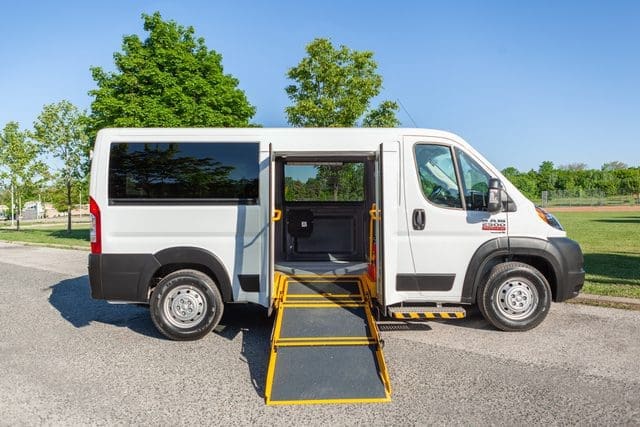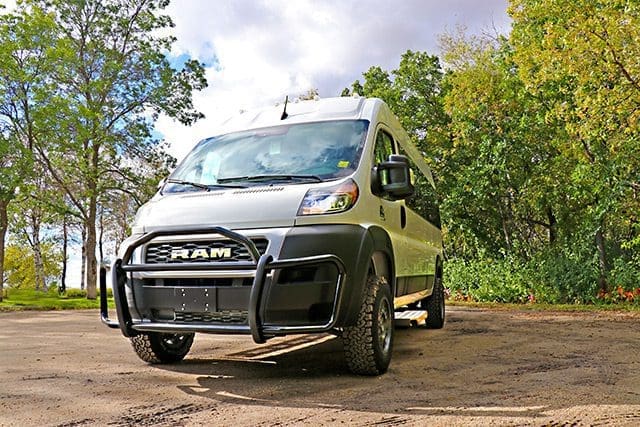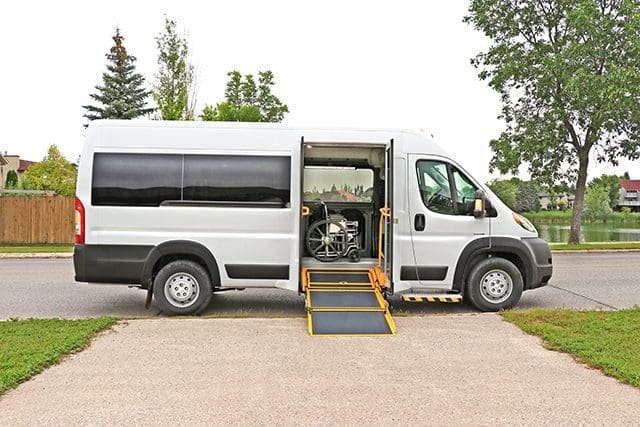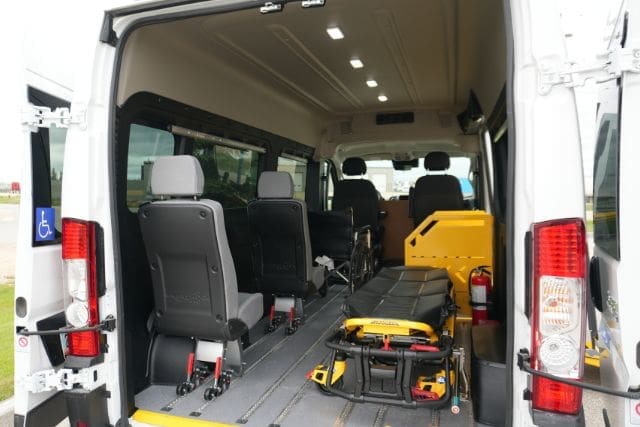Do you live in a remote community only accessible through rough winter roads? Or do you live in a place that gets a lot of snow in winter?
For whatever reason you’re here, you likely have one specific question:
Should you stick with a standard wheelchair van, or is an off-road wheelchair van right for your organization?
The answer to this question mainly depends on two things:
- Where you live
- The roads you drive on
With these two factors in mind, the team at MoveMobility created an off-roading upgrade for any of our P-Series and T-Series vehicles. Through 10 years of experience, we’ve learned what remote communities need to safely transport patients to and from important engagements, such as doctor’s appointments.
Read on to learn the differences between a standard and off-road wheelchair van and, ultimately, which option is right for you.
Standard wheelchair van vs. off-road wheelchair van: what’s the difference?


When comparing a standard wheelchair van to an off-road wheelchair van, we can look at our Trail Package Upgrade at MoveMobility–an upgrade you can make to any of our P-Series or T-Series vehicles.
An off-road wheelchair van (a vehicle with a Trail Package Upgrade) includes:
- Front grille guard
- Upgraded shocks
- Upgraded tires (10-Ply)
- Limited electrical components
- A lift kit for higher ground clearance
- Underbody protection package to protect from debris
A standard wheelchair vehicle does not include any of these upgraded components.
Please note: The primary purpose of the Trail Package Upgrade is to transport wheelchairs/stretchers/people. Even with these upgrades, keep in mind that it is not designed for “off-roading” per se but for rougher terrain in remote communities.
Standard wheelchair van vs. off-road wheelchair van: comparing both options
There are a few key differences between a standard wheelchair van and an off-road wheelchair van that may help you determine which option is best for your organization, and they are:
- How each option navigates rough terrain/road conditions
- What drivetrains are available for each option
- How accessible each option is to all levels of mobility
Let’s take a look at how each option navigates rough terrain/road conditions.
Navigating rough terrain/road conditions
Standard van
A standard wheelchair van can be configured to run well on rough terrain and road conditions, but it isn’t specifically built to handle them.
Off-road van
An off-road wheelchair van, on the other hand, has been built specifically to handle rough terrain and road conditions, by including things like a front grille guard, upgraded shocks, and an underbody protection package to protect it from debris.
An off-road wheelchair van–or, specifically, MoveMobility’s Trail Package Upgrade–provides safe, easy transportation for clients who live in remote locations and may need to use rough winter roads in poor conditions.
Now that you understand how both options navigate rough terrain/road conditions, let’s dive into the next part: what drivetrains are available for each option?
Different drivetrain availability
AWD, RWD, and FWD are all different drivetrains that you choose from when purchasing a vehicle, and each drivetrain has a specific purpose–whether that’s to gain traction in all conditions, or just in snow. Read on to learn what each drivetrain means for your vehicle.
AWD (all-wheel-drive)
AWD means that the engine powers all 4 wheels.
At MoveMobility, only our T-Series vehicles are available with an AWD drivetrain.
RWD (rear-wheel-drive)
Also called two-wheel-drive, RWD means the engine powers the back two wheels.
At MoveMobility, our T-Series vans are RWD.
FWD (front-wheel-drive)
As you might be able to guess, in a FWD vehicle only the two front wheels are powered by the engine.
The engine’s weight is above the front wheels, so having power go directly to the front helps drivers maintain traction in snowy conditions.
At MoveMobility, our P-Series vehicles are all FWD, making them the perfect option if you frequently drive on rough winter roads.
Ease of accessibility for all levels of mobility
Standard van
A standard wheelchair van is typically accessible to people with all levels of mobility, whether they use walkers, canes, or wheelchairs.
Off-road van
An off-road wheelchair van can also typically be configured to be accessible for all levels of mobility.
That being said, one thing to keep in mind is if you get an off-road wheelchair van with a lift package, there will be a bigger step for patients to get into the vehicle.
This is because the vehicle is higher up off the ground to provide more ground clearance, which you need when driving on rough winter roads.
When deciding which option is right for you, consider your location and what is most important to your organization.
Do you need off-road capabilities or easy accessibility for all community members?
This question may help you determine which option is right for your organization.
Standard wheelchair van vs. off-road wheelchair van: which is right for your organization?
Take a look at some of the qualities down below. They may help you determine which option is right for you.
A standard wheelchair van is right for:
- Organizations that don’t live in remote communities
- Organizations that need easy accessibility for all community members, such as transit services
An off-road wheelchair van is right for:
- Organizations situated in remote locations
- Communities that can only be accessed through rough winter roads
Once again, please note that the primary purpose of the Trail Package Upgrade is to transport wheelchairs/stretchers/people. Even with these upgrades, keep in mind that it is not designed for “off-roading” per se but for rougher terrain in remote communities.
Your next steps for choosing between a standard wheelchair van and an off-road wheelchair van

You came to this article to learn if a standard or off-road wheelchair van is right for your organization.
Now, you know how they’re different and who each option is right for.
If you’re unsure which option is right for you, talk to a MoveMobility expert today.
Or, check out these related resources for more information:








